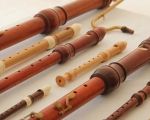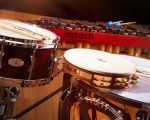How Musical Instruments Produce Sound: Understanding the Science Behind Music
May 03, 2025
How Musical Instruments Produce Sound: Understanding the Science Behind Music
As a music lover, I’ve always been fascinated by how the beautiful sounds of musical instruments are created. Whether it's the rich tones of a piano, the soaring strings of a violin, or the powerful blasts from a brass horn, every instrument has a unique way of producing sound. Understanding how musical instruments produce sound is not only fascinating but also helps us appreciate the science behind the music we enjoy. In this article, we’ll dive into the basic principles that explain how different instruments make sound.
1. The Role of Vibration in Sound Production
At the core of sound production is vibration. All musical instruments, regardless of their type, rely on vibrations to generate sound. In simple terms, sound is created when an object vibrates, causing the air around it to move, which then travels to our ears as sound waves. Let’s take a closer look at how vibration plays a role in sound production for various instruments:
Stringed Instruments (e.g., Guitar, Violin): When you pluck, strum, or bow the strings, they vibrate. The frequency of these vibrations determines the pitch of the sound produced. Higher vibrations result in higher pitches, while slower vibrations produce lower pitches.
Percussion Instruments (e.g., Drums, Tambourines): In percussion instruments, the membrane or surface vibrates when struck. The size and tension of the surface affect the tone, while the force of the strike affects the volume of the sound.
Wind Instruments (e.g., Flute, Trumpet): These instruments create vibrations through the movement of air. When air is blown through or across a pipe or mouthpiece, it creates a vibration that travels through the instrument. The shape and length of the instrument determine the pitch, and the mouthpiece’s design affects the tone quality.
2. Resonance: Amplifying the Vibrations
Once vibration is created, resonance amplifies the sound, making it louder and richer. Resonance occurs when an object or chamber naturally vibrates at the same frequency as the source of the sound, thereby amplifying it. This principle is particularly evident in stringed and wind instruments, where the body of the instrument acts as a resonator:
String Instruments: The body of a violin, for example, acts as a resonator. When the string vibrates, the sound waves travel through the bridge and into the hollow body, amplifying the sound.
Wind Instruments: In brass instruments like trumpets and trombones, the bell of the instrument amplifies the sound waves as they exit the instrument. The larger the bell, the greater the amplification.
Percussion Instruments: The shape and material of the drum body also serve as resonators. A larger drum or one with a thicker membrane will often produce a deeper, richer sound.
3. Air Movement in Wind Instruments
One of the most intriguing ways sound is produced is in wind instruments. Here, air plays a crucial role in generating vibrations. Wind instruments can be broadly classified into two categories: reed instruments (like the clarinet and saxophone) and non-reed instruments (like the flute and trumpet).
Reed Instruments: In reed instruments, the player blows air between two reeds, causing them to vibrate. This vibration creates the sound that travels through the body of the instrument. The size and shape of the reed and the air pressure used to blow into it can alter the tone and pitch of the sound.
Non-Reed Instruments: In instruments like the flute, air is blown across an opening, causing the column of air inside the tube to vibrate. By changing the finger placements and covering different holes, players can change the pitch.
4. How Brass Instruments Produce Sound
Brass instruments like the trumpet, trombone, and tuba rely on the musician’s lips to create vibrations. When the player buzzes their lips into the mouthpiece, the air inside the instrument vibrates, producing sound. The pitch is altered by adjusting the tension of the lips, changing the shape of the mouthpiece, or using valves to lengthen or shorten the air passage.
Lip Vibrations: The musician’s ability to control lip tension is critical for producing a clean sound and achieving different notes on a brass instrument.
Mouthpiece and Bell: The shape of the mouthpiece helps focus the sound, while the bell amplifies the vibrations as they exit the instrument.
5. Woodwinds and the Power of Breath
Woodwind instruments are fascinating because they rely solely on the player’s breath to create sound. Instruments like the flute, oboe, and clarinet produce sound when air is directed through a mouthpiece or across an opening. The player controls the pitch and tone by varying their breath pressure and adjusting fingerings on the instrument.
Flutes and Piccolos: For instruments like the flute, the air is blown across an opening at the head joint, causing the air column inside to vibrate. The player’s breath and the positioning of their fingers help create the melody.
Reed-Based Woodwinds: In clarinets and oboes, the air causes a reed to vibrate. The reed’s thickness and the player’s breath control influence the tone and pitch.
6. Modern Technology and Sound Production
While traditional instruments still rely on the principles of vibration and resonance, modern technology has introduced new ways to manipulate sound. Electric guitars, synthesizers, and electronic music production utilize electronic components to generate and modify sound waves. For example:
Electric Guitars: Instead of relying on a hollow body to resonate sound, electric guitars use magnetic pickups to convert string vibrations into electrical signals, which are then amplified and processed to create unique sounds.
Synthesizers: These instruments generate sound electronically by manipulating sound waves with various filters and effects, allowing musicians to create virtually any sound they desire.
7. The Fascination of Sound Production Across Different Instruments
What makes musical instruments so captivating is the unique way each one produces sound. From the vibrations of strings and reeds to the resonance of brass and woodwinds, every instrument has its own way of interpreting sound. Understanding how musical instruments produce sound not only enhances our appreciation for music but also opens up a world of creativity for musicians and enthusiasts alike.
Whether you're playing an instrument or simply enjoying a performance, the science behind sound production helps us connect with music on a deeper level. It’s a reminder that music is not just an art form but a science that has been honed for centuries.
If you're interested in learning more about how instruments produce sound or exploring music creation, visit Tengerszem Music for a deeper dive into musical techniques and instruments.







